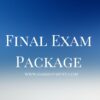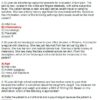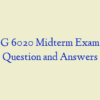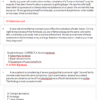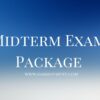Description
NSG 6020 Final Exam – Question and Answers
- Once a practice problem has been identified the next step would be to use the PICOT format to ask a question about the problem. PICOT stands for:
- The Affordable Care Act has directed the US Department of Health and Human Services and multiple agencies to develop and disseminate initiatives on meeting the care needs of patients with Multiple Chronic Conditions (MCC). What is the primary purpose for this national direction?
- After thoroughly researching the topic of interest, what is the next step an APN should ask in selecting a theory/ model for use in practice or research?
- Which three roles represent the accepted advanced practice nursing roles?
- What are the three major categories of Nola Pender’s Health promotion model?
- Which theorist/s identifies carative factors as a value system, faith-hope and sensitivity to self and others? This describes which of the following theories?
- What set of components is essential in a scientific theory?
- The term advanced nursing practice (APN) includes nurses who are:
- To meet Medicare’s coverage requirements, the Nurse Practitioner’s services must be:
- A 20-year-old female comes to the primary care clinic with clinical findings consistent with acute bronchitis. She is sexually active with a male partner, although she states prior to this relationship she did have two sexual partners. Her menses occurs every 28 days and is regular. An example of a primary prevention activity for this patient is:
- Which agency’s initiative establishes national health promotion and prevention efforts and establishes benchmarks for monitoring the progress of health among Americans over a 10-year timeframe?
- Development of the first pediatric nurse practitioner program at the University of Colorado in 1965 is credited to which two individuals?
- Raynaud phenomenon is classified as a type III hypersensitivity reaction and is due to:
- The nurse practitioner is caring for a 21 year old female who presents with a pruritic, erythematous rash matching pattern of her sandal straps. The nurse practitioner advises the patient to avoid scratching the area due to the risk of the developing a secondary infection. The nurse practitioner understands that the most likely etiology of secondary skin infections are caused by which organism?
- How can the APN best influence development and passage of a specific health policy agenda?
- Which is the gold standard research design for generating evidence?
- The advanced practice nurse is examining a client with new onset hypertension. The nurse practitioner recognizes that hypertension may result in significant complications associated with which of following three organs:
- Which organization allows the use of the “BC” credential (e.g., FNP-BC)?
- The US Department of Health and Human Services (Incorrect! The Agency for Health, Research and Quality houses the USPSTF.)
- Which two organizations administer nurse practitioner certification programs?
- Transformational leadership is best defined as:
- A metaparadigm must include which of the following 3 characteristics?
- Which statement best reflects King’s theory?
- Which agency will the APN reference when seeking the current evidence based guidelines directing standards of care?
- A 43-year old woman has a 12-hour history of sudden onset of right upper quadrant abdominal pain with radiation to the shoulder, fever, and chills. She has had similar, milder episodes in the past. Examination reveals marked tenderness to right upper quadrant abdominal palpation. Her most likely diagnosis is:
- What theory is used to describe the cause of endometriosis?
- “Chronic pain, physical disability, social support, age and gender are related to perceived daily stress, which is related to depression”. This is an example of which type of theory?
- The leadership core competency of advanced practice nursing includes which three characteristics?
- What initiative specifically focuses on the aging American, under the Affordable Care Act?
- Which of the following philosophies of work view would characterize human beings as holistic; parts are viewed only in the context of the whole?
- A difficult aspect of determining occupational exposure to disease is the:
- A novice nurse practitioner (NP) is experiencing feeling of inferiority toward more experienced clinicians in the practice. She has identified that time constraints for visits and expectations to increase productivity limits her ability to address these non-adherent issues during client visits. Which barrier to ethical practice is influencing practice?
- Utilizing Johnson’s Behavioral systems model (JBSM), the APN discovers that a patient is not sure who he can depend on because his wife is emotionally distant. This data would be characteristic of which subsystem of the JBSM?
- “A purposeful, complex, dynamic, collaborative, and holistic interpersonal process aimed at supporting and facilitating patients and families through health-related experiences and transitions to achieve health-related goals (mutually determined when possible)” defines which APN role?
- A 60-year-old female with a history of emphysema presents to the primary care office with complaints of cough and shortness of breath at rest. During the physical exam, the nurse practitioner recognizes clubbing, barrel chest, and prolonged expiration. The nurse practitioner understands that the patient is exhibiting symptoms resulting from which type of pulmonary disease process?
- Which of the following statements accurately defines Hamric’s conceptual definition of advanced practice nursing?
- When caring for a client who presents with pain and swelling to location of the metacarpophalangeal (MCP) and proximal interphalangeal (PIP) joints. Which diagnostic test is most specific to diagnosis of rheumatoid arthritis?
- The Consensus Model for Advanced Practice Registered Nurse Regulations addresses which four areas?
- Which statement best supports primary prevention of burns for geriatric clients?
- Which of the following three complications are associated with chronic hepatitis B?
- The central competency, direct clinical practice, is characterized by which three of the following?
- Which payment system seeks Medicare reimbursement under the MACRA legislation for providing high quality patient-specific care and improved outcomes?
- What four components of advanced practice nursing (APN) are specified by the National Council for State Boards of Nursing Consensus Model for APRN regulation?
- Which learning theory would be most applicable as a guide for the development of a program to help families of patients in palliative care?
- What terms indicate appropriate progression associated with the history and evolution of advance practice nursing?
- An experienced NP, has two separate but equally important ethical obligations that he is unfortunately unable to carry out. This is an example of which barrier to ethical practice?
- Pre-invasive epithelial tumors of glandular or squamous cell origin describes which of the following?
- Which two options are barriers to the conceptualization of Advanced Practice Nursing?
- The Dreyfus Model of Skill Acquisition includes which four stages of APN performance?
- The nurse practitioner is caring for a client who has undergone a recent gastrectomy who complains of fatigue, palpitations, shortness of breath, and numbness and tingling to their fingers on both hands. The nurse suspects pernicious anemia related to:
- The analysis of a theory or conceptual model includes examining the origins. Which would not be considered an aspect of origin of the theory/model?
- The clinical manifestations of dyskinetic cerebral palsy include:
- Which core competency incorporates assuming complex collaborative roles with stakeholders and communities?
- A critical environmental element that affects the authority of advanced practice nurses to practice to their fullest/maximum scope, according to Hamric’s model, is:
- For nursing to be considered a discipline which statement is true?
- The APN wants to develop a community educational program for hypertension and stroke prevention. She recognizes that the individual’s lifestyle and pattern of behavior need to be addressed for the program to be successful. Which theory would be most appropriate to guide the program development?
- When considering a theory for use in guiding practice, the APN should examine the Conceptual-Theoretical-Empirical (C-T- E) linkages by for which criteria?
- In septic shock, which mediators are anti-inflammatory?
- The link between major depression and cortisol secretion is that individuals with depression:
- Which three primary criteria for advanced practice nursing are identified in Hamric’s Integrative Model of Advanced Practice Nursing?
- Which advance practice nursing (APN) was developed to facilitate delivery of high quality, patient-centered primary care?
- An adult-gerontology nurse practitioner is employed in a rural practice that is initiating a school-based primary healthcare program. All nurse practitioners in the practice are required to initiate preparations to facilitate conducting patient visits in the new setting. Which role concepts best describes what the adult-gerontology nurse practitioner is experiencing?
- A MSN student is noting challenges related to attending school while attempting to balance other work, family, and social responsibilities. Which of the following role concepts illustrates the MSN student’s experience?
- A 24 year old female presents to the primary care office with complaints of dysuria. Urinalysis lab results indicated positive nitrites. The nurse practitioner plans to initiate antibiotic coverage for the most likely causative organism which is:
- Place the following four steps of APN core competency of evidence based practice in order.
- A 12-year-old male is diagnosed with Klinefelter syndrome. His karyotype would reveal which of the following?
- Concerning the MMR vaccine, which of the following is a correct statement?
- You are seeing a 40-year-old patient who has started varenicline (Chantix) 3 weeks ago as a tool for smoking cessation. What is the most important question to ask during the visit?
- A primary care nurse practitioner (NP) is seeking additional support from ancillary health services for a diabetic client who is noncompliant with nutrition, exercise, and medication. Which barrier to ethical practice is influencing the NP’s practice?
- Which hospital ownership classification best describes an organization whose excess income is distributed to its shareholders?
- How has the Quality Chasm Report been used to direct US health care?
- A 12-year-old female is newly diagnosed with type 1 DM. When the parents ask what causes this, what is the nurse practitioner’s best response?
- Which patient below is at most risk for invasive pneumococcal infection?
- A Latino patient in your clinic has been perpetually late for his appointments. Which action by the nurse practitioner would be most appropriate?
- What specific developments have primarily occurred because of the Affordable Care Act (ACA)?
- Hamric’s Integrative Model of Advanced Practice Nursing identify the central competency of advance practice nursing that directs the other six core competencies.
- A public health nurse is teaching the community about health promotion. When explaining immunity, the APN discusses that innate immunity is:
- According to Madeline Leininger, cultural care/accommodation/negotiation refers to actions/ decisions that help a particular culture:
- The nurse practitioner is conducting annual physical exam on a 62 year old male. Which of the following risk factors will prompt the nurse practitioner to screen the patient for development of benign prostatic hypertrophy (BPH)?
- The family nurse practitioner examines a patient who has sustained a non-work-related injury that interferes with his ability to perform his job. The patient does not qualify for medical disability and has a reasonable chance of engaging in a suitable occupation with proper therapy. What type of services or benefits should the nurse practitioner recommend?

